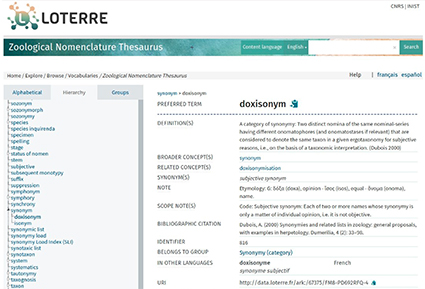Abstract
Zoological nomenclature is the discipline of taxonomy responsible for regulating the scientific names of animal species. It has its roots in Carolus Linnaeusʼ work and has been governed by an international Code since the turn of the 20th century. Its vocabulary, on the other hand, is not always clear. Various authors have established new terminology in order to reduce ambiguity. To make these new terms, but also the classical terms used by the International Code of Zoological Nomenclature, accessible, an electronic thesaurus (link: https://www.loterre.fr/skosmos/FM8/en/) was created, allowing to compare existing terminologies. This thesaurus is also a tool for reflection and discussion, targeting taxonomists and experts in nomenclature.
References
Anonymous [International Commission on Zoological Nomenclature] (1999) International code of zoological nomenclature. 4th Edition. International Trust for zoological Nomenclature, London, XXIX + 306 pp.
Anonymous [World Wide Web Consortium] (2009) SKOS Simple Knowledge Organization System Reference. Available from: https://www.w3.org/TR/skos-reference/ (accessed 10 June 2021)
Anonymous [Technical Committee ISO/TC 46, Information and documentation, Subcommittee SC 9, Identification and description] (2011) ISO 25964-1:2011 Information and documentation—Thesauri and interoperability with other vocabularies—Part 1: Thesauri for information retrieval. Available from: https://www.iso.org/obp/ui/#iso:std:iso:25964:-1:ed-1:v1:en (accessed 11 June 2021)
Anonymous [International Commission on Zoological Nomenclature] (2012) Amendment of Articles 8, 9, 10, 21 and 78 of the International Code of Zoological Nomenclature to expand and refine methods of publication. Bulletin of zoological Nomenclature, 69 (3), 161–169. https://doi.org/10.21805/bzn.v69i3.a8.161
Anonymous [Technical Committee ISO/TC 46, Information and documentation, Subcommittee SC 9, Identification and description] (2013) ISO 25964-2:2013 Information and documentation—Thesauri and interoperability with other vocabularies—Part 2: Interoperability with other vocabularies. Available from: https://www.iso.org/obp/ui/#iso:std:iso:25964:-2:en (accessed 11 June 2021)
Anonymous [World Wide Web Consortium] (2015) Vocabularies, Available from: https://www.w3.org/standards/semanticweb/ontology (accessed 10 June 2021)
Blanchard, R. (1905) Règles internationales de la nomenclature zoologique. International rules of zoological nomenclature. Internationale Regeln der zoologischen Nomenklatur. Rudeval, Paris, 64 pp.
Broughton, V. (2006) Essential thesaurus construction. Facet, London, 295 pp. https://doi.org/10.29085/9781856049849
Dmitriev, D.A. & Yoder, M. (2020) NOMEN. Available from: https://github.com/SpeciesFileGroup/nomen (accessed 28 September 2021)
Dubois, A. (2000) Synonymies and related lists in zoology: general proposals, with examples in herpetology. Dumerilia, 4 (2), 33–98.
Dubois, A. (2005) Proposed Rules for the incorporation of nomina of higher-ranked zoological taxa in the International Code of Zoological Nomenclature. 1. Some general questions, concepts and terms of biological nomenclature. Zoosystema, 27 (2), 365–426. https://doi.org/10.11646/zootaxa.1337.1.1
Dubois, A. & Ohler, A. (1996) Early scientific names of Amphibia Anura. I. Introduction. Bulletin du Muséum national d’Histoire naturelle, Series 4, 18 (3–4), 317–320.
Farber, P.L. (1976) The type-concept in zoology during the first half of the nineteenth century. Journal of the History of Biology, 9 (1), 93–119. [Publication date: Spring 1976] https://doi.org/10.1007/BF00129174
Hawksworth, D.L. (2010) Terms used in bionomenclature: the naming of organisms (and plant communities). Global Biodiversity Information Facility (GBIF), Copenhagen, 216 pp.
Linnaeus, C. (1758) Systema naturae per regna tria naturae, secundum classes, ordines, genera, species, cum characteribus, differentiis, synonymis, locis. Editio decima, reformata. Tomus 1. Laurentii Salvii, Holmiae [Stockholm], IV + 824 pp. https://doi.org/10.5962/bhl.title.542
Rousset, M. (2021) Opentheso webpage, Hypotheses. Available from: https://opentheso.hypotheses.org/ (accessed 31 May 2021)
Simpson, G.G. (1940) Types in modern taxonomy. American Journal of Science, 238, 413–431. https://doi.org/10.2475/ajs.238.6.413
Strickland, H.E., Henslow, J.S., Phillips, J., Shuckard W.E., Richardson, J., Waterhouse, G. R., Owen, R., Yarrell, W., Jenyns, L., Darwin, C., Broderip, W.J. & Westwood, J.O. (1843) Series of propositions for rendering the nomenclature of zoology uniform and permanent, being the Report of a Committee for the consideration of the subject appointed by the British Association for the Advancement of Science. Annals & Magazine of Natural History, Series 1, 11 (70), 259–275. https://doi.org/10.1080/03745484309445300
Wüster, W., Thomson, S.A., O’She, M. & Kaiser, H. (2021) Confronting taxonomic vandalism in biology: conscientious community self-organization can preserve nomenclatural stability. Biological Journal of the Linnean Society, 133 (3), 645–670. https://doi.org/10.1093/biolinnean/blab009


